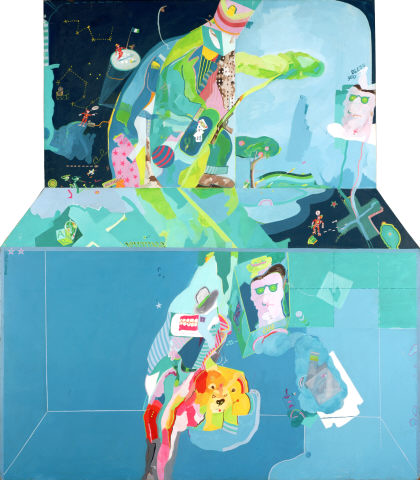
- 1967
- Wood
- Acrylic paint
- Inv. 81P697
Eduardo Batarda
I Like Art ou a Perspectiva do Costume com Água no Bico [I Like Art or The Usual Perspective with Double Entendres]
ARTIST STATEMENT
Considered by the artist himself to have been the pièce de résistance of his first individual exhibition (1968), this work was painted on a curious polygonal stretcher, enabling the play of trompe l’œil in the lower section, a cube or box projecting into deep space, but with the artifice of its perspectival construction exposed by the extension of its orthogonals. Using fluorescent paint, Eduardo Batarda obtained unusual contrasts and luminosities, but these effects have dissipated over time. With cynical humour, the painting evokes various elements of vernacular language, politics and religion, while simultaneously commenting on art history. The work also alludes to strategic maps, to landscape painting and its relations with topography, property and abstraction, and to the earth seen from space (‘the earth is blue’, noted Yuri Gagarin, the first man to travel in the earth’s orbit). Various motifs are distinguishable, including a Hitler-like head, decapitated and wearing dark glasses. A bird saying ‘bless you’ seems both to refer to the ironic idea of Hitler being ‘blessed’ (in English) and to respond to the ‘ACHTUNG’ which appears in cut-out letters on the edge of the box, as if spit out in an apoplectic speech of the Nazi leader. This Hitlerian figure is repeated on the lower panel, with the number 2 and a colonial hat, together with the inscription ‘CHAG’, part of the Jewish greeting for feast days, ‘chag sameach’ (‘happy holidays’). At the same time, it evokes other words: Chagall, chaga (Portuguese for both wound and nasturtium), KAG, CAG (Cape Verde, Angola and Guinea Bissau), all implicit allusions to the Portuguese Colonial War.
Other images and textual inscriptions invoke further associations: the artist’s strategy is to establish connotations, ambiguities and double (or triple) entendres, to some extent deployed to bypass censorship, but above as part of the language of painting itself. The tiny figure inside one of the sketched boxes/cubes floating in space is surmounted by a comic-like speech bubble with the somewhat ironic inscription ‘I like art,’ reminiscent of the slogan used for Eisenhower’s 1952 presidential campaign, ‘I like Ike.’ However, being part of the title [the expression appears in English in the Portuguese title], the expression invites us to reflect upon its literal meaning: to like art (or painting) because it removes all hierarchies, flattening them onto the same plane, linking them together, putting everything into the same basket (or, in this case, into the same box), while simultaneously commenting the tradition and the formal specificity of this kind of telling histories, calling forth, for example, classical perspective. Hence, in the painting as in the title, ‘the usual perspective’ alludes to the work’s capacity to mask meanings with hidden intentions.
Mariana Pinto dos Santos
May 2010
| Type | Value | Unit | Section |
| Height | 195 | cm | |
| Width | 170 | cm |
| Type | signature |
| Text | Batarda |
| Position | front, left margin |
| Type | date |
| Text | 67-68 |
| Position | front, left margin |
| Type | inscription |
| Text | «I LIKE ART», «OOPS», «BOOM», «ACTION», «BLESS YOU», «MCMD», «HOLY CRO», «ACHTUNG», «CHAG», «SO NICE», «AH AH», «ACR», «ARREEA», «BATARDA 67.68» |
| Type | Acquisition |
| Date | July 1981 |
| Anos 60, anos de ruptura, uma perspectiva da arte portuguesa nos anos sessenta |
| Lisboa, Livros Horizonte, 1994 |
| ISBN:972-24-0867-4 |
| Exhibition catalogue |
| Eduardo Batarda: Pinturas, 1965-1998 |
| Lisboa, Fundação Calouste Gulbenkian, Centro de Arte Moderna José Azeredo Perdigão, 1998 |
| Exhibition catalogue |
| Exposição Permanente do CAM / Permanent Exhibition at CAM |
| CAM/FCG |
| Curator: Jorge Molder |
| 18 Julyd 2008 to 4 January 2009 Centro de Arte Moderna |
| Anos 60, anos de ruptura, uma perspectiva da arte portuguesa nos anos sessenta |
| Câmara Municipal de Lisboa |
| Curator: António Rodrigues |
| 1994 Palácio Galveias, Lisbon |
| Eduardo Batarda |
| Quadrante gallery |
| 1968 Quadrante gallery, Lisbon |